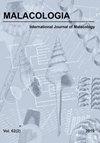引进西西里岛的一种帽贝(帽贝科),被追溯到它在斯里兰卡的家乡,并被描述为一个新种
IF 1
4区 生物学
Q4 ZOOLOGY
引用次数: 1
摘要
对最近报道引进地中海西西里岛的一种帽贝进行的持续分子和形态学研究表明,它是1833年洛蒂亚·格雷(Lottia Gray)的一种未被描述的物种,该属原产于斯里兰卡及其北印度洋附近。来自西西里岛和斯里兰卡的帽贝的遗传和形态特征非常接近,以至于我们毫不犹豫地将其统称为Lottia iani n. sp,类型地点为斯里兰卡海岸的Tangalle。关于它的原生地,何时以及如何到达西西里岛,它是否有能力影响当地物种,以及它的引入是否可能在地中海比仅在西西里东部观察到的特定地区更广泛,仍有很多未知。有一种说法似乎是合理的,那就是由于最近苏伊士运河的扩张导致了西西里岛上L. iani的引入,众所周知,这导致了近年来其他物种的引入。其他可能性包括与航运或海水养殖活动有关的介绍。不管它是如何到达的,这种帽贝显然已经能够在西西里的岩石火山海岸上建立一个自我招募的地方种群。本文章由计算机程序翻译,如有差异,请以英文原文为准。
A Limpet (Lottiidae), Introduced to Sicily, is Traced to Its Homeland in Sri Lanka and Described as a New Species
ABSTRACT Continuing molecular and morphological investigations of a limpet recently reported as introduced to Sicily in the Mediterranean Sea have revealed it to be an undescribed species of Lottia Gray, 1833, a genus that is native to Sri Lanka and vicinity in the northern Indian Ocean. The genetic and morphological features of the limpets compared from Sicily and Sri Lanka correspond so closely that we do not hesitate to describe it collectively as Lottia iani n. sp., with type locality of Tangalle on the coast of Sri Lanka. Much is still unknown about its native range, when and how it arrived in Sicily, whether it is capable of impacting native species, and whether its introduction might be more widespread in the Mediterranean than just the particular eastern Sicilian localities where it has been observed. It is plausible that the introduction of L. iani to Sicily could have resulted from recent expansions to the Suez Canal, which is known to have led to other species introductions in recent years. Other possibilities include an introduction related to shipping or mariculture activities. However it managed to arrive, this limpet species has clearly been able to establish a self-recruiting local population at particular Sicilian localities with rocky volcanic shores.
求助全文
通过发布文献求助,成功后即可免费获取论文全文。
去求助
来源期刊

Malacologia
生物-动物学
CiteScore
2.00
自引率
0.00%
发文量
15
审稿时长
3 months
期刊介绍:
Malacologia publishes papers on all groups of the Mollusca. Malacologia specializes in publishing long papers and monographic treatments. Complete data are especially appreciated. Papers must be of interest to an international readership. Papers in systematics, ecology, population ecology, genetics, molecular genetics, evolution and phylogenetic treatments are especially welcomed. Also welcomed are letters to the editor involving papers published or issues of import to science of the day.
 求助内容:
求助内容: 应助结果提醒方式:
应助结果提醒方式:


